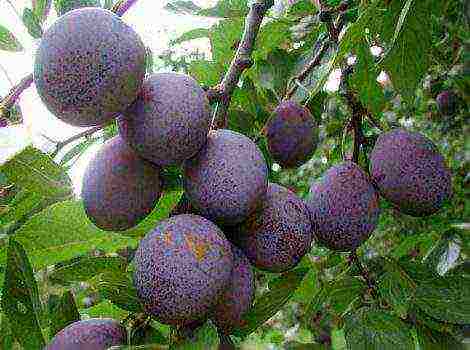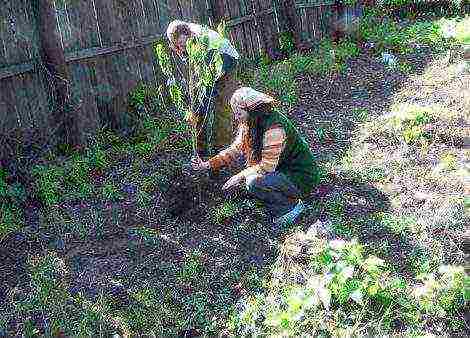Content
Plums are one of the most delicious and healthy fruits. They are used not only fresh, but also in the preparation of culinary dishes, as well as in preparations for the winter.
Dried plums or prunes are a valuable low-calorie product, which has healing properties due to its high content of vitamins and other nutrients, especially potassium.
Plums for making prunes must meet certain requirements:
- the percentage of dry matter is about 20%;
- the concentration of sugars in fruits - from 12%;
- moisture and acid content - up to 1%;
- fruit weight - from 30 to 40 g;
- skin color - dark blue;
- the fruits have a dense, intact skin, covered with a waxy coating, the stone is small.
What varieties of plums are suitable for making prunes?
Most suitable for drying and obtaining excellent prunes of the varieties Vengerka, Renklod, Adyghe prune, Blue bird.
Articles that may interest you:
- When and how to properly collect plums from a tree?
- Prunes and plums - what's the difference?
- How to make prunes at home?
Varieties such as Mirabelle, early blue, apricot and some others do not dry, since good prunes will not work out of them.
Hungarian
Hungarian is one of the most popular and common varieties of plum for prunes. Its fruits have excellent taste, high sugar content and ideal for drying.
Some varieties of Hungarian:
- B. Italian - self-fertile (does not require planting near the pollinator variety) mid-season variety. It is cultivated mainly in the southern regions, as it can freeze out at low temperatures. The trees are not tall, up to 5 m high, the crown diameter does not exceed 6 m. Begins to bear fruit in 4 or 5 years, the average yield is 50 kg of plums. Average weight of fruits - 35 g. Does not tolerate drought.
- B. home - late variety, demanding on heat. It is characterized by rapid growth, the average height is 6.5 m. Fruiting begins from 7–8 years of cultivation. At the age of 20, with optimal care, the maximum tree yield reaches 150 kg. Fruit weight - about 20 g.
- V. Wangenheim - an early variety, resistant to frost and diseases, can grow on insufficiently fertile soil. To increase the yield, it is recommended to carry out re-pollination of inflorescences. Already in the 6th year of cultivation, the seedling yields 15 kg of yield; upon reaching 10 years of age and older, its average yield is 60 kg. Fruit weight is about 30 g.
- V. korneevskaya - self-fertile mid-season variety, withstands frost and drought well. Begins to bear fruit for 3-4 years. Purple fruits weighing up to 35 g. Trees give bountiful harvests: already at the age of 6 they can reach 30 kg.
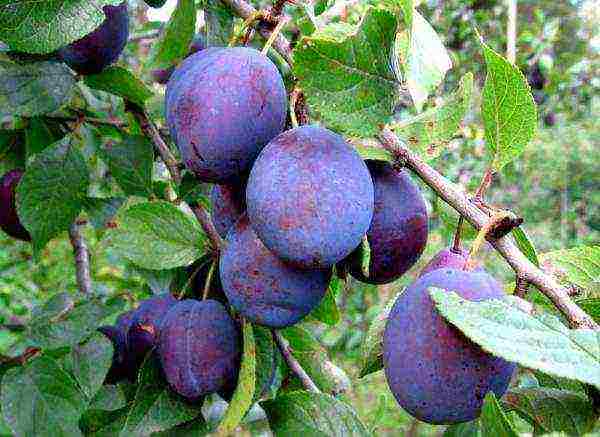
Renklod Karbyshev
Early high-yielding variety, the weight of the fruit is about 40 g. The stone is easily separated from the pulp. The crown of the tree is dense and requires regular pruning.
Adyghe prunes
Medium late self-fertile variety with abundant but periodic fruiting. Resistant to frost, drought, fungal diseases. The average fruit weight is 40 g.
Blue bird
Mid-season with abundant and regular fruiting... The first fruits appear as early as 2-3 years of growing the seedling. The average weight of the fruits is 45 g, they have excellent taste and an easily detachable seed.
The trees are self-fertile, resistant to cold and disease.

Raisin-eric
Crimean medium late plum variety... Trees require planting near pollinating varieties. They bring abundant harvests, at the age of 20 - from 115 kg. Fruiting begins from the 7th - 8th year from the moment of planting.
The size of the fruits is small, the shape is elongated pear-shaped, the average weight is 9.5 g. The trees are resistant to drought, grow better on fertile moisture-permeable soil.
How to properly dry prunes
Prunes are prepared from well-ripe fruits.that have accumulated a maximum of sugar and nutrients. Fruits that have fallen from a tree have the optimum degree of ripeness.
When selecting for drying, rotten, wormy, damaged plums should be rejected.
The process of preparing prunes has its own characteristics.... It is impossible to achieve the required product quality by drying plums alone.
In this case, the fruits will lose their juice, their pulp will acquire excessive rigidity, and the skin will become not black, but brown.
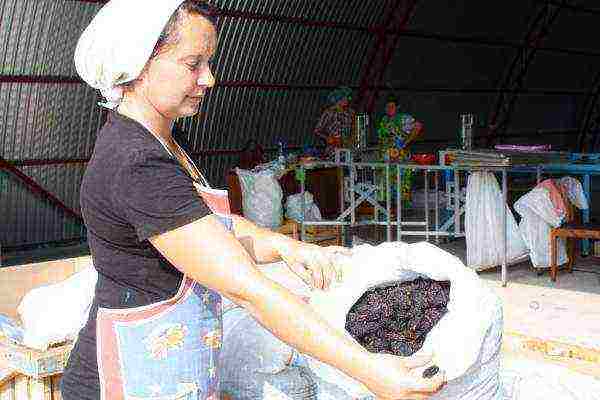
To obtain the required product special preparation of berries is required, its stages:
- Drying drains are stored in basketslocated on the territory of covered areas. The maximum number of fruits placed in them should not exceed 16 kg. In this form, the fruit can be stored for up to 3 days in order to avoid spoilage of the plum due to fermentation processes.
- Before starting drying the fruits are washed thoroughly until the water obtained after rinsing them is absolutely clear.
- Then plum is sorted, separating large from small, with the subsequent rejection of berries that are not suitable for drying.
- Selected fruits once again washed and blanched in hot water... This softens their tissues, removes the air contained in them and leads to the expansion of the drain cells. In the process of blanching, oxidizing elements are destroyed with almost complete preservation of vitamins and other valuable substances.
- To remove wax deposits from the surface of berries they are lowered for 15-20 seconds in 1% solution of caustic soda... At home, it is difficult to completely wash off the remnants of soda from the fruit, so it is better to replace it with potash.
- Cooling drains, while many cracks form on their surface. They provide a slow release of moisture from the fruit, preventing the skin from bursting with a rapid loss of all juice, which will exclude the receipt of real prunes.
How prunes are made:
For this purpose, in a production environment, use multi-deck drying cabinets or tunnel (duct) dryers.
Initially, the fruits wilt slightly at 40-50 ° C for 3-5 hours so that they do not burst. Then the temperature is raised and drying is continued until the dried fruit acquires the required condition.
At this stage, biochemical processes take place in the tissues of the fruit, ensuring the acquisition of its characteristic taste qualities by the prune.
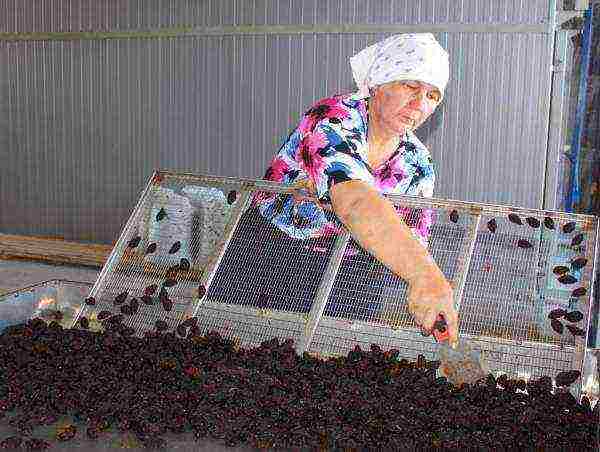
Drying plums at home
When making prunes yourself the rules for preparing and drying plums should be followed as much as possible.
In the absence of special drying equipment, you can use a conventional oven or dry the fruit in the open air.
At home, you can dry plums in two ways:
- Evenly spreading the fruits in one layer on plywood sheets or other suitable surface located in direct sunlight... Plums must be turned over from one side to the other to avoid mold growth. After 5 days of drying in the sun, the fruits are transferred to the shade for final drying.
- In ovens the first 4 hours, the berries filled with juice are kept at 45 ° C, then turning off the heat to cool the fruits for 4 hours. In a next drying step of the same duration, the temperature is raised to 60 ° C, followed by cooling. The third stage lasts from 8 to 10 hours. The drying temperature during it rises to 75 ° C. When 3-5 minutes remain until the end of the process, you can raise the temperature to 100 ° C to give the dried fruit a beautiful shine.
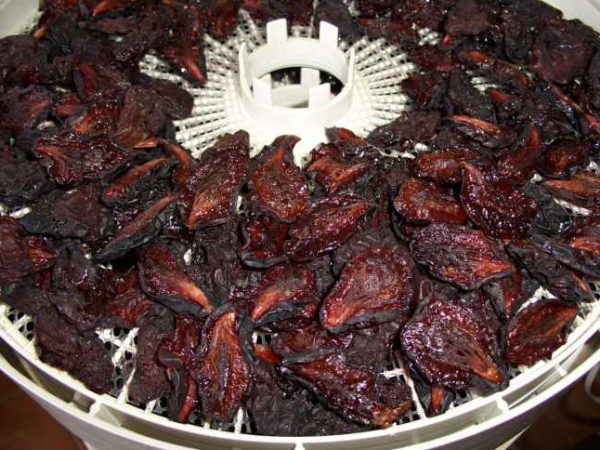
When ready, prunes have a soft structure; their tissues contain a certain amount of juice, which ensures their elasticity. But at the same time, moisture does not come out of the dried fruit even when it is squeezed with considerable force.
It is used as an ingredient in various culinary dishes, for the preparation of sweets and confectionery.
Eating prunes inhibits the growth of bacteria and can be used to prevent tooth decay and inflammatory gum disease.
It improves the functioning of the digestive tract, normalizes blood pressure, strengthens the nervous system.
How to cook prunes at home:
